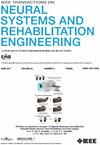Footropter:可调节前脚掌和后脚掌硬度的被动假体处方工具
IF 4.8
2区 医学
Q2 ENGINEERING, BIOMEDICAL
IEEE Transactions on Neural Systems and Rehabilitation Engineering
Pub Date : 2025-04-09
DOI:10.1109/TNSRE.2025.3559253
引用次数: 0
摘要
商业上可用的假脚被制造成具有固定的前脚和后脚刚度,在临床环境中不能改变。这就不允许患者在行走时快速比较多个假肢足的刚度来选择他们最喜欢的刚度。在本文中,我们介绍了Footropter,这是一种被动假肢足处方工具,允许认证假肢医师(CPs)快速改变前脚和后脚的刚度。通过沿一段未粘合的玻璃纤维层重新定位弹簧钳来改变前脚刚度,通过重新定位单个后跟弹簧支撑来改变后脚刚度。我们介绍了Footropter的设计和工作原理,描述了可用的前脚和后脚刚度范围,并通过对两名单侧胫骨假体使用者的偏好和感知研究展示了Footropter的实用性。当footroter与偏好优化算法配对时,可以使CPs将患者的经验输入整合到临床处方过程中。本文章由计算机程序翻译,如有差异,请以英文原文为准。
The Footropter: A Passive Prosthetic Prescription Tool With Adjustable Forefoot and Hindfoot Stiffness
Commercially available prosthetic feet are fabricated to have a fixed forefoot and hindfoot stiffness that cannot be changed in a clinical setting. This does not allow for patients to quickly compare multiple prosthetic foot stiffnesses to choose the stiffness they like the most while walking. In this paper, we present the Footropter, a passive prosthetic foot prescription tool that allows Certified Prosthetists (CPs) to rapidly change both the forefoot and hindfoot stiffnesses. The forefoot stiffness is changed by repositioning a spring clamp along a length of unbonded fiberglass layers and the hindfoot stiffness is changed by repositioning a single heel spring support. We introduce the design and working principles, characterize the ranges of available forefoot and hindfoot stiffnesses, and demonstrate the utility of the Footropter through two preference and perception studies with two unilateral transtibial prosthesis users. The Footropter, when paired with a preference optimization algorithm, can enable CPs to integrate patients’ experiential input into the clinical prescription process.
求助全文
通过发布文献求助,成功后即可免费获取论文全文。
去求助
来源期刊
CiteScore
8.60
自引率
8.20%
发文量
479
审稿时长
6-12 weeks
期刊介绍:
Rehabilitative and neural aspects of biomedical engineering, including functional electrical stimulation, acoustic dynamics, human performance measurement and analysis, nerve stimulation, electromyography, motor control and stimulation; and hardware and software applications for rehabilitation engineering and assistive devices.

 求助内容:
求助内容: 应助结果提醒方式:
应助结果提醒方式:


